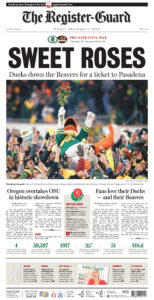Adjusting to a shifting news media landscape

2007-2017
By Mark Baker
For The Register-Guard
By the end of 2007, The Register-Guard’s average daily circulation had fallen below 70,000, finishing at 68,727, for the first time since 1988.
By the end of 2016, it would fall to 41,189, the lowest circulation since 1960 – a time when Lane County’s population was about 162,000, less than half of what it is now.

But those are print numbers. The Register-Guard of today is more than that, having rebranded itself RG Media Company in January 2016.
The Register-Guard is the largest-circulation seven-day-a-week home-delivered newspaper in the state. It also has about 600,000 visitors to its website, registerguard.com, every month, says Sally Wickes, the company’s director of marketing and brand development. Thousands more (about 9,000 a month) read the e-Edition (the digital replica of the newspaper) online, and the RG News app (about 4,000 users a month) and Ducks Sports app (about 3,000 a month) on their smartphones, Wickes says.
“All of these digital platforms are showing healthy growth,” she says. “The apps are growing at double digit rates year over year. While our print readership used to be mainly Lane County, our audience is now national and global and bigger than ever before.
“What’s interesting now is that because of these different platforms, readers can choose when and how to get their news. Often they come to a story on registerguard.com via one of our several email newsletters or from RG social media, which includes Facebook, Twitter, Instagram and YouTube. Readers also access RG news from their friends and family or other sources who share our stories on their own social media pages.”
Until June 2013, registerguard.com was free to anyone who had Internet access, but as many newspapers have done, the company began charging for online access that month, beyond a limited number of page views. (Print subscribers get access to the website and all digital products for no additional cost).
“The reason is simple and straightforward,” then-Editor and Publisher Tony Baker said in a statement to readers. “The economics of our business have changed dramatically. While we reach more readers than ever before, many of them are reading the news (online). Circulation revenue must supplement advertising revenue for our digital content, just as it does for print.”
RG Media Company also has ventured into the website-building business, having launched in 2014 a Digital Services department, which has created more than 40 websites for local businesses and organizations.
All of these ventures beyond the printed newspaper are why Logan Molen refuses to see The Register-Guard’s glass as anything but half full.

“It’s a challenging future, and we just have to recognize that the rules have changed, and the environment has changed,” says Molen, 55, hired in July 2016 as The Register-Guard’s publisher and chief executive officer. “We just have to be nimble in recommitting to the original mission of local newspapers, which is to connect our community. It’s not to produce news and then sell advertising around it – at its core, it’s connecting the community to itself,” says Molen, who is the second straight Register-Guard publisher hired from outside the Baker family after N. Christian Anderson III, previously publisher of The Oregonian from 2009 to 2015, served just six months in the role, from June to December in 2015.
Several third- and fourth-generation Baker family members continue to work at the company (the family celebrated 90 years of ownership on March 1) including: Dave Baker, managing editor; Wendy Baker, human resources director and general counsel; Rick Baker, chief information officer; Bridget Baker, public relations director; and Shelly Rondestvedt and Dave Johnson, retail salespersons in advertising.
In 1900, there were 2,042 daily newspapers (with 2,023 owners) in the United States, according to the late Ben Bagdikian’s 1983 book, “Media Monopoly.” By 1983, that number had dropped to 1,730, according to Bagdikian, who was a media critic and the one-time dean of the University of California, Berkeley, Graduate School of Journalism.
Today, there are 1,331 daily newspapers in the United States, according newspaperownership.com, a website run by the University of North Carolina School of Media and Journalism – and 721 of them, as of 2014, were owned by 25 media companies.
In other words, family- and independently owned newspapers have become more and more rare with each passing year.
Last year, two prominent family-owned newspapers – the Columbia (Mo.) Daily Tribune, owned for 111 years by the Waters family, and the Fayetteville (N.C.) Observer, owned for 93 years by the Broadwell family – sold to what is now the nation’s largest newspaper chain, GateHouse Media, according to newspaperownership.com.
Will the Baker family make it to 100 years of family ownership come 2027?
“I personally feel it would be wrong to quit – to actually quit,” says Ted Baker, who was born in 1923 and is one of only two Bakers, along with younger brother Herb, who was alive when their father purchased the Eugene Guard in 1927. “I don’t like the idea of selling the newspaper. I think we owe the community something. It’s an enterprise that is important. Whether (the community) is excited about it or not, I don’t know. We’ve got those that object, and we’ve got those that believe in what we’re doing, and it’s very vital and important to me. Always has been, always will be. That’s just the way it is.”
Despite working with a smaller staff, the company continues to produce award-winning journalism.
In 2012, Editor & Publisher magazine chose The Register-Guard as one of the “10 Newspapers That Do It Right” in its annual list of newspapers “that demonstrate flexibility, creativity, sound judgment and a commitment to high quality journalism in some unique manner,” mostly based on a four-day series, “Called to Duty,” that ran in December 2011.
To mark the 70th anniversary of the attack on Pearl Harbor, The Register-Guard invited local World War II veterans to come to the newspaper to be photographed by Paul Carter, then assistant graphics director. The paper photographed and interviewed 130 veterans.
Their images and stories, written by columnist Bob Welch, were printed between Dec. 4 and Dec. 7. Graphics Director Rob Romig came up with the concept and handled the logistics of the project.
“The response from readers was unlike anything I’ve ever seen in my 32 years in journalism,” Dave Baker told Editor & Publisher. “Over several weeks we received emails, letters to the editor, phone calls and comments praising the series. The portraits and stories are powerful, poignant tributes to these local heroes, and they resonated with our most loyal readers.”
The Register-Guard sports staff routinely places in the top 10 in the annual Associated Press Sports Editors competition for newspapers between 30,000 and 75,000 circulation. Most recently, sports columnist Austin Meek placed first nationally for his 2016 work in both column writing and explanatory writing, and the Sunday sports section was considered among the nation’s 10 best.

The photo and design staffs recently showed once again why they’re among the best in the nation, taking first place nationally in March in the National Press Photographers Association’s Best of Photojournalism contest for work done in 2016. The Register-Guard won first place in the NPPA’s “Best Use of Pictures” category for U.S. newspapers with less than 65,000 circulation. (The New York Times won in the 65,000 and above competition.)
The return of the U.S. Olympic Track & Field Trials in 2008, 2012 and 2016 gave both the sports and photo staffs a chance to highlight their work in special sections produced during the 10-day events.
And the news staff, despite losing reporters in the past decade through attrition and layoffs – the Great Recession took its toll on an already ailing newspaper industry from 2007 to 2009, including at The Register-Guard, which had double-digit layoffs in the spring of 2009 – continues to hold the powerful accountable.
Examples in recent years include:
In 2013, The Register-Guard filed a lawsuit against Lane County in an attempt to get it to release the full report of the county’s investigation into former county Administrator Liane Richardson, previously released in a heavily redacted version. On the verge of a trial, the county finally relented in 2014.
In June 2016, The Register-Guard obtained documents showing that a small group of 13 members of taxpayer-funded Trillium Community Health Plan insiders had divvied up $34 million in profits, most of them local doctors who had contributed several thousand dollars apiece back in the 1990s, after selling to a Fortune 500 company for $109 million.
“I think more than ever there’s a need for a constant when it comes to information and news, and we’re committed to providing that balance and that perspective that is harder and harder to find,” Molen says. “I’d rather have a mission that focuses on providing good storytelling that is completely different from what people can get anywhere else, and it’s exclusive and it’s rewarding, and when people put down our product or they’re reading the product, we trigger an emotional reaction that says, ‘That was worth my time.’ And whether it’s a happy feeling or it’s a negative feeling, the key is you’ve got to trigger that emotional reaction. If you don’t get any reaction out of somebody? That’s the worst.”
Mark Baker, who researched and wrote the stories for this special section, is a former Register-Guard reporter and a member of the third generation of the Baker family.

Mark Baker has been a journalist for the past 25 years. He’s currently the sports editor at The Jackson Hole News & Guide in Jackson, Wyo.
